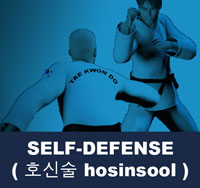Taekwondo 태권도Taekwondo Preschool
When you reach senior belt you are expected to guide the junior belts when they are beginning Taekwondo such as showing by example. To advance from one rank to the next, students typically complete promotion tests in which they demonstrate their proficiency in the various aspects of the art before a panel of judges or their teacher. View Taekwondo belt levels »

Other Forms of Self Defense
Taekwondo self-defense competition provides an opportunity for students to display their understanding of Taekwondo self-defense applications and the ability to put together their own team choreography.
Avoidance
Being aware of and avoiding potentially dangerous situations is one useful technique of self-defense. Attackers are typically larger, stronger, and are often armed or have an accomplice. These factors make fighting to defeat the attacker unlikely to succeed. When avoidance is impossible, one often has a better chance at fighting to escape, such methods have been referred to as 'break away' techniques.
De-escalation
Verbal Self-Defense is defined as using one's words to prevent, de-escalate, or end an attempted assault. It is a way of using words as weapons or as a shield. This kind of 'conflict management' is the use of voice, tone, and body language to calm a potentially violent situation before violence actually ensues. This often involves techniques such as taking a time-out, and deflecting the conversation to individuals in the group who are less passionately involved, or simply entering into protected empathic position to understand the attacker better.
Personal Alarms
Personal alarms are a way to practice passive self-defense. A personal alarm is a small, hand-held device that emits strong, loud, high-pitched sounds to deter attackers because the noise will sometimes draw the attention of passersby. Child alarms can function as locators or device alarms such as for triggering an alert when a swimming pool is in use to help prevent dangerous situations in addition to being a deterrent against would-be aggressors.

Training Safety Precautions
Usually before the taekwondo class starts, the master ( 사범님 sabeomnim ) instructs the students to jog around the dojang to warmup. Depending on the size of the dojang, several laps are done. Risk of injury can be reduced by completing an effective warm-up consisting of a heart raiser to get your pulse up, followed by sport specific dynamic stretches (stretches whilst moving).
* Please see a certified Master Instructor ( 사범님 sabeomnim ) for training. Proper guidance and instructions are needed to ensure safe training.

Related Articles
Self-Defense ( 호신술 hosinsool ) is to protect yourself from being attacked from would-be aggressors. It is a countermeasure that involves defending the health and well-being of oneself from harm and is designed primarily to cause injury or quickly incapacitate an attacker, in addition to being a deterrent against them. Attackers are typically larger, stronger, and are often armed or have an accomplice. With proper execution attackers may be incapacitated with a single blow, which lessens the number of attacks with multiple people. View Self-Defense ( 호신술 hosinsool ) »
Risk of injury can be reduced by completing an effective warm up consisting of a heart raiser to get your pulse up, followed by sport specific dynamic stretches (stretches whilst moving). Please follow the guidance of a certified Master Instructor or trainer when doing sports related activities. Depending on the intensity of the exercise, cooling down can involve a slow jog or walk, or with lower intensities, stretching can be used. Cooling down allows the heart rate to return to its resting rate. View more information on Warming Up and Cooling Down ».
This article uses material from the Wikipedia articles "Warming Up" and "Cooling Down", which is released under the Creative Commons Attribution-Share-Alike License 3.0.
RESOURCES
This article uses material from the Wikipedia article "Self Defense", which is released under the Creative Commons Attribution-Share-Alike License 3.0.




























